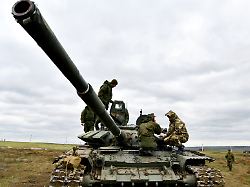Thaw puts time pressure
Russia launches offensive in eastern Ukraine
02/09/2023, 11:45 am
Attacks by Russian troops in the Luhansk region are increasing, the expected offensive is probably beginning. On the one hand, this is due to the approaching anniversary of the invasion and, on the other hand, to the impending change in the weather. Time is of the essence for the Russian army. And Putin wants to show a success.
According to the local governor, the Russian military has significantly increased the attacks in eastern Ukraine. The Russian army is trying to break through the Ukrainian lines at Kreminna, the governor of the Luhansk region, Serhiy Hajday, told Ukrainian television. So far, however, they have not been successful.
Kreminna is about 100 kilometers northwest of the regional capital Luhansk and had a population of about 18,000 before the Russian invasion. A few kilometers away are the cities of Sjewerodonetsk and Lyssychansk, which were conquered by Russian troops in the summer of last year after long and costly fighting. Should Russian forces break through Ukrainian defenses in the area, they could advance a little further toward the major cities of Kramatorsk and Sloviansk.
This comes to a similar conclusion Institute for War Studies (ISW). The current daily report states that the Russian armed forces have again taken the initiative and launched the long-awaited major offensive in the Luhansk region. The Russian attacks near Swatowe and Kreminna had increased significantly, and more and more military equipment and troop contingents had recently been transferred to the region. Unlike in the area around Soledar and Bachmut, however, regular Russian soldiers and no fighters from the Wagner mercenary group were deployed. So far, the Ukrainian soldiers have been able to hold the defense lines, they say. However, according to the ISW assessment, Russia’s offensive has not yet reached its full pace.
Muddy ground would make offensive difficult
Many experts had expected the start of a major offensive in early or mid-February. On the one hand, there was speculation that Russian President Vladimir Putin wanted to present measurable successes on February 24, the anniversary of the invasion – after the invasion had so far been marked by numerous setbacks. On the other hand, the weather plays a decisive role in the success of a Russian offensive.
According to the findings of the British secret service, the ground in Ukraine is still largely frozen, but the temperatures are already around 0 degrees again, so that the first mud can form. They are expected to increase further in the near future. This would result in heavy vehicles such as tanks or armored personnel carriers getting stuck in the muddy ground. This circumstance caused considerable problems for the Russian troops in the previous year. And it could make success much less likely.
A few days ago, Russian military bloggers made similar statements. The Russian military leadership is in a hurry to start its offensive due to the impending thaw, according to social media channels. Despite the current start of the offensive, Russian nationalist Igor Girkin is not convinced of its success. In his eyes, the currently concentrated troops are not enough. “Without a new wave of mobilization, we will not be able to defeat Ukraine,” he wrote Telegram.
